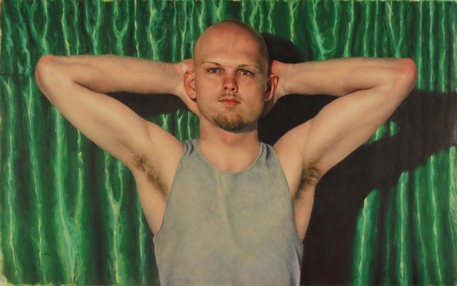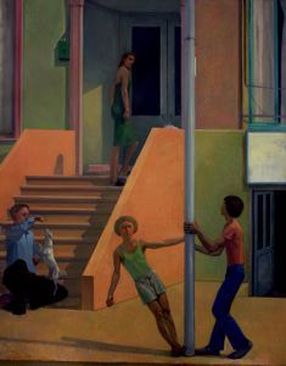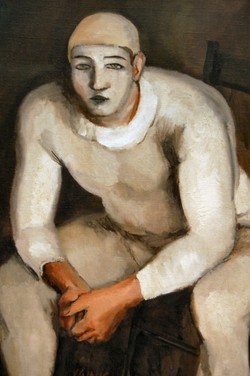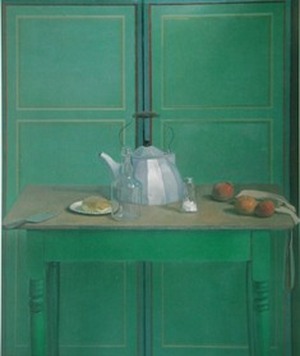 Lennart Anderson, "Still Life with Kettle", 1977
Lennart Anderson, "Still Life with Kettle", 1977 I first became a devotee of Lennart Anderson at the Contemporary American Realism since 1960 exhibition, curated by Frank Goodyear Jr., at the Pennsylvania Academy of Fine Arts in 1981. That was a watershed exhibition for me, not only because of the exhaustive scope of the exhibition and Goodyear's expansive definition of realism, but because it introduced me to three of the most influential paintings of my development: Anderson's Still Life with Kettle, William Beckman's Double Nude, and Gregory Gillespie's Myself Painting a Self-Portrait.
What all three paintings share, besides the green background, is the insistent dominance of the subject. Anderson's kettle is infused with a solemn reality, an uncompromising presence that emphasizes it's materiality. Beckman's nudes are startling in their confrontation yet we are compelled to empathize even while wanting to turn away. Gillespie's emaciated and psychologically-challenged figure courageously battling the green curtain behind him is the most interesting character we've ever seen. I review Myself Painting a Self-Portrait daily: it is the background on my iphone. My painting homage to it is Myself Painting Luke.
What all three paintings share, besides the green background, is the insistent dominance of the subject. Anderson's kettle is infused with a solemn reality, an uncompromising presence that emphasizes it's materiality. Beckman's nudes are startling in their confrontation yet we are compelled to empathize even while wanting to turn away. Gillespie's emaciated and psychologically-challenged figure courageously battling the green curtain behind him is the most interesting character we've ever seen. I review Myself Painting a Self-Portrait daily: it is the background on my iphone. My painting homage to it is Myself Painting Luke.
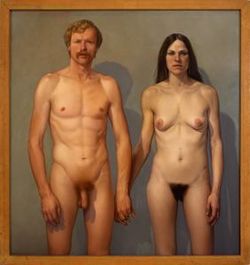 William Beckman, "Double Nude", 1978
William Beckman, "Double Nude", 1978 Goodyear referred to the realism post-1960 as "New Realism" because it is so pluralistic and reflects both a revisionist and avant-garde bias - meaning that it is not constrained by the realist conventions of the past, especially the heavily didactic 19th century. The three paintings in question also relate to another aesthetic direction of the 1980's; "New Image Painting".
New Image painting is an interesting mixture of pop and expressionistic sensibilities that examines everyday objects disassociated from their backgrounds or environments in a simplified representational style. The artists are said to be influenced by Philip Guston's later style but there is also reference to early abstractionists like Marsden Hartley. Purveyors include Jennifer Bartlett, Neil Jenney, and Susan Rothenberg.
It is the focused examination of one subject with all its attending implications that connect Anderson, Beckman and Gillespie to New Image painting (certainly not style) and what resonated with me so powerfully so long ago. There were many incredible paintings in the exhibition from painters that still inspire me like Robert Bechtle, Rackstraw Downes, Philip Pearlstein, and Neil Welliver, but the three paintings in question seemed to embody the purest philosophy of deconstruction: the courage to lay bare only the most essential visual idea through elimination of the unnecessary. That is the guiding principal of modern art and is clearly obvious in New Image painting and some of the New Realism as well.
New Image painting is an interesting mixture of pop and expressionistic sensibilities that examines everyday objects disassociated from their backgrounds or environments in a simplified representational style. The artists are said to be influenced by Philip Guston's later style but there is also reference to early abstractionists like Marsden Hartley. Purveyors include Jennifer Bartlett, Neil Jenney, and Susan Rothenberg.
It is the focused examination of one subject with all its attending implications that connect Anderson, Beckman and Gillespie to New Image painting (certainly not style) and what resonated with me so powerfully so long ago. There were many incredible paintings in the exhibition from painters that still inspire me like Robert Bechtle, Rackstraw Downes, Philip Pearlstein, and Neil Welliver, but the three paintings in question seemed to embody the purest philosophy of deconstruction: the courage to lay bare only the most essential visual idea through elimination of the unnecessary. That is the guiding principal of modern art and is clearly obvious in New Image painting and some of the New Realism as well.
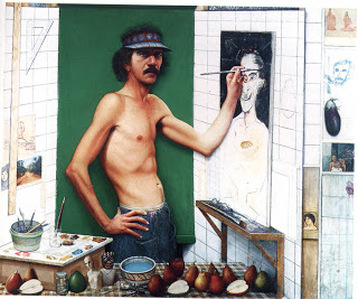 Gregory Gillespie, "Myself Painting a Self-Portrait", 1980
Gregory Gillespie, "Myself Painting a Self-Portrait", 1980 New Image and New Realism have both had a very positive effect on painting. By breaking with the conventions of 19th century realism and embracing pluralism through myriad approaches like photorealism, direct observation, abstraction, pop, and even surrealism, Goodyear says the new realism has enlarged and increased the resources of painting: giving the artists more options for expression. Also, New Realism and New Image both arrived when much of the contemporary art scene had been focused on performance, installation and conceptual art. They returned to the formal thrills of the media and application that were the hallmark of the Abstract Expressionists. For the industry, they are credited with keeping art alive by providing artwork that is actually sellable.
